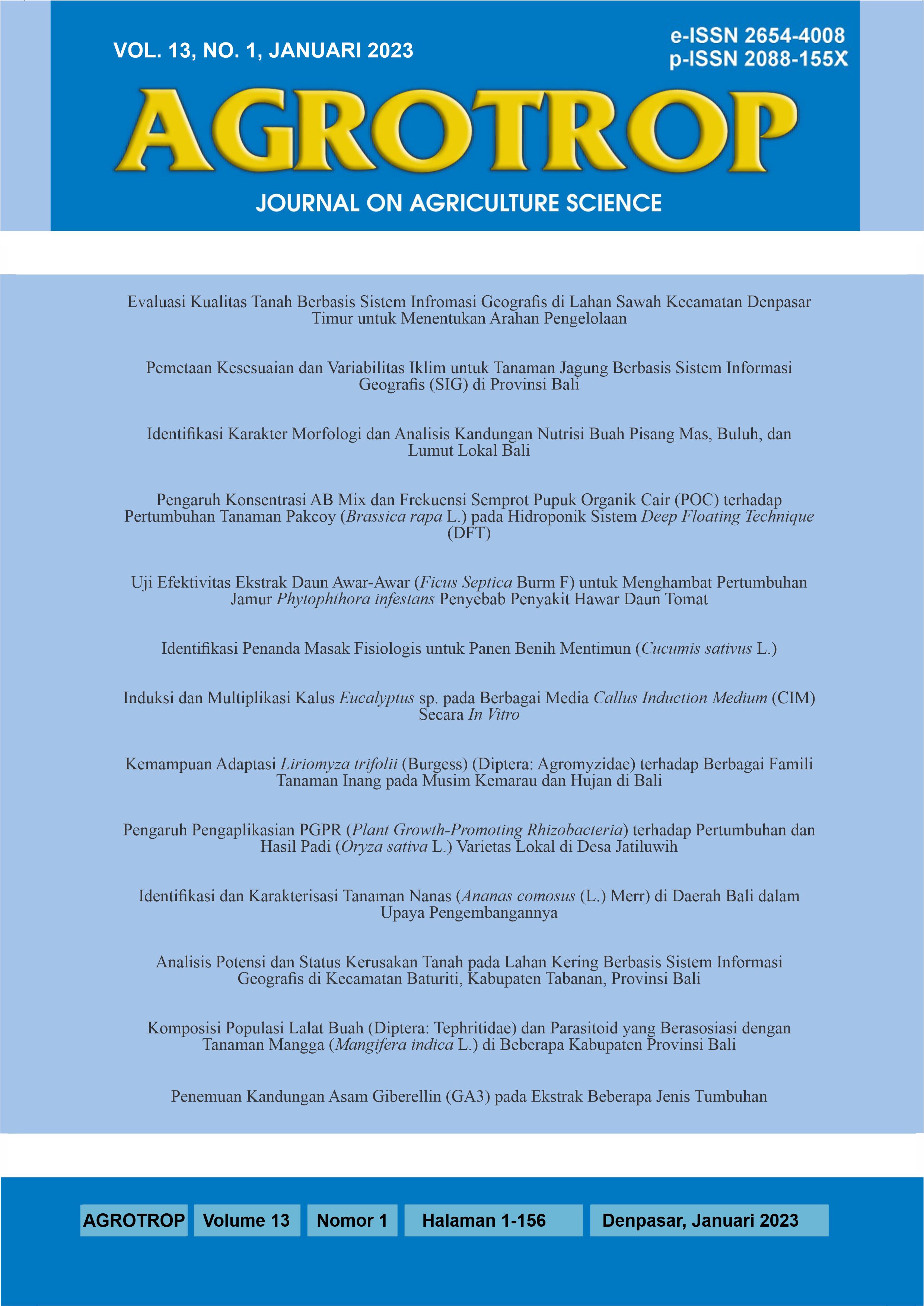Identifikasi Karakter Morfologi dan Analisis Kandungan Nutrisi Buah Pisang Mas, Buluh, dan Lumut Lokal Bali
Abstract
Identification of Morphological Characters and Fruits Nutrient Analysis of Pisang Mas, Buluh and Lumut Local Bali. Banana are a common commodity in Indonesia, having high economic, cultural and nutritional value. The objective of this research was to find the difference of morphological characters and nutrient content of Pisang Mas, Buluh and Lumut Local Bali. The research was conducted from July to October 2021. The samples of banana were taken from Antap Village, Selemadeg Barat District, Tabanan Regency, while identification and analysis were conducted in the laboratory. This research used UPGMA analysis and randomize complete design (RCD) with 3 replications. The results of identification showed different qualitative morphological characters in bunch position, fruit shape, fruit apex, remains of flower relicts at fruit apex, mature peel color, pedicel surface, pulp color before maturity, pulp color at maturity and predominant taste, while the quantitative showed the different in the number of pedicels, fruit length, fruit pedicel length and fruit peel thickness. Pulp nutrient content showed differences in water content, dry matter, crude lipid, crude fiber, and carbohydrate content.
Downloads
References
Daniells, J.W. 2003. Bananas and plantains, in: B. Caballero (Ed.), Encyclopedia of Food Sciences and Nutrition, 2 ed., Academic Press, Oxford, 2003, pp. 372–378.
Darmawati, I.A.P. 2019. Eksplorasi dan Karakterisasi Fenotipik-Genotipik Anggrek Dendrobium Forma Bali, Serta Evaluasi Kompatibilitas Hibridisasinya. Disertasi Doktor. Universitas Udayana. Denpasar
Dotto, J., A.O. Matemu, & P.A. Ndakidemi. 2019. Nutrient composition and selected physicochemical properties of fifteen Mchare cooking bananas: A study conducted in northern Tanzania.ScientificAfrican 6:e00150. ttps://doi.org/10.1016/j. sciaf.2019.e00150.
Drzikova, B., G. Dongowski, E. Gebhardt, & A. Habel. 2005. The composition of dietary fiber-rich extrudates from oat affects bile acid binding and fermentation in vitro, Food Che. 90 (1): 181–192, doi:10.1016/ j.foodchem.2004.03.041.
Hapsari, L. & D.A. Lestari 2016. Fruit characteristic and nutrient values of four Indonesian banana cultivars (Musa spp.) at different genomic groups. Agrivita Journal of Agricultural Science 38(3): 303-311. https://agrivita.ub.ac.id/ index.php/agrivita/article/view/696/785.
Haslinda, W., L. Cheng, L. Chong, & A.N. Aziah. 2009. Chemical composition and physicochemical properties of green banana (Musa acuminata × balbisiana Colla cv. Awak) flour, Int. J. Food Sci. Nutr. 60 (4): 232–239, doi:10.1080/09637480902915525.
Hijova, E., & A. Chmelarova. 2007. Short chain fatty acids and colonic health, Bratisl. Lek. Listy 108 (8): 354-362.
IPGRI (International Plant Genetic Resources Institute). 1996. Descriptor for banana (Musa sp). INIBAP. http://banana.bioversity international.
Ohizua, E.R., A.A. Adeola, M.A. Idowu, O.P. Sobukola, T.A. Afolabi, R.O. Ishola, S.O. Ayansina, T.O. Oyekale, & A. Falomo. 2017. Nutrient composition, functional, and pasting properties of unripe cooking banana, pigeon pea, and sweetpotato flour blends, Food Sci. Nutr. 5 (3): 750-762. Doi:10.1002/fsn3.455.
Oyeyinka, B.O., & A.J. Afolayan. 2019. Comparative Evaluation of the Nutritive, Mineral, and Antinutritive Composition of Musa sinensis L. (Banana) and Musa paradisiaca L. (Plantain) Fruit Compartments. Plants 8(598): 1-14. doi:10.3390/plants8120598.
Rai, I.N., F.M. Dwivany., A. Sutanto., K. Meitha., I.M. Sukewijaya., & I.N.G. Ustriyana. 2018. Biodiversity of Bali Banana (Musaceae) and its Usefulness. Hayati Journal of Biosciences 25(2):47-53. https://journal.ipb.ac.id/index.php/hayati/article/view/23530/15312.
Rai, I.N., I. M. Sudana, I.N.G., Astawa, R. Dwiyani, & Y. Fitriani. (2019). Direct organogenesis in vitro propagation of local balinese banana with thidiazuron. International Journal of Life Sciences 3(3): 32-40. https:// doi.org/10.29332/ijls.v3n3.360
Souza, E., & M.E. Sorrells, 1991. Relationships among 70 North American oat gerplasms: I. Cluster analysis using quantitatif characters. Crop Sci. 31:599–605. DOI: 10.2135/cropsci1991. 0011183X003100030010x
Zhang, H., S. Yang, D.C. Joyce, Y. Jiang, H. Qu, & X. Duan. 2010. Physiology and quality response of harvested banana fruit to cold shock, Postharvest Biol. Technol. 55 (3) (2010) 154–159.











